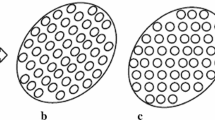Abstract
A considerable number of viruses’ structures have been discovered and more are expected to be identified. Different viruses’ symmetries can be observed at the nanoscale level. The mechanical models of some viruses realised by scientists are described in this paper, none of which has taken into consideration the internal deformation of subsystems. The authors’ models for some viruses’ elements are introduced, with rigid and flexible links, which reproduce the movements of viruses including internal deformations of the subunits.
Similar content being viewed by others
References
Voet, D., Voet, J., Pratt C.: Fundamentals of Biochemistry: Life at the Molecular Level. 3rd edn, 124–160 (2008)
Guest, S.D., Kovács, F., Tarnai, T., et al.: Construction of a mechanical model for the expansion of a virus. In: Proceedings, IASS-2004, Montpellier, France, September 20–24 (2004)
Kovacs, F., Tarnai, T., Guest, S.D., et al.: Double-link expandohedra: a mechanical model for expansion of a virus. Proc. R. Soc. Lond. A 460(2051), 3191–3202 (2004)
Kovacs, F.: Mobility and stress analysis of highly symmetric generalized bar-and-joint structures. Journal of Computational and Applied Mechanics 5(1), 65–78 (2004)
Speir, J.A., Munshi, S., Wang, G., et al.: Structures of the native and swollen forms of CCMV determined by X-ray crystallography and cryo-electron microscopy. Journal Structure 3(1), 63–78 (1995)
Ingber, D.E.: The architecture of the life. Scientific American Magazine 278, 48–57 (1998)
Scarr, G.: Simple geometry in complex organisms. Journal of Bodywork and Movement Therapies 14(4), 424–444 (2010)
Stamenović D., Ingber, D.E.: Tensegrity-guided self assembly: from molecules to living cells. Journal Soft Matter 5(5), 1137–1145 (2009)
Wang, N., Naruse, K., Stamenović D., et al.: Mechanical behavior in living cells consistent with the tensegrity model. PNAS 98(14), 7765–7770 (2000)
Sanchez, A., Yang, Z.Y., Xu, L., et al.: Biochemical analysis of the secreted and virion glycoproteins of ebola virus. Journal of Virology 72(8), 6442–6447 (1998)
Burkhardt, R.W. Jr.: A Practical Guide to Tensegrity Design. Cambridge University Press (2005)
Estrada, G.G.: Analytical and numerical investigations of form-finding methods for tensegrity structures. [PhD Thesis]. Max-Planck-Institut fur Metallforschung und Universitat Stuttgart Press (2007)
Cretu, S.M., Brinzan, G.C.: Mechanical structures for expansion of viruses. In: Proceedings of DSTA 2009, Łódź, Poland, December 7–10, 971–976 (2009)
Author information
Authors and Affiliations
Corresponding author
Rights and permissions
About this article
Cite this article
Simona-Mariana, C., Gabriela-Catalina, B. Tensegrity applied to modelling the motion of viruses. Acta Mech Sin 27, 125–129 (2011). https://doi.org/10.1007/s10409-011-0402-7
Received:
Revised:
Accepted:
Published:
Issue Date:
DOI: https://doi.org/10.1007/s10409-011-0402-7




